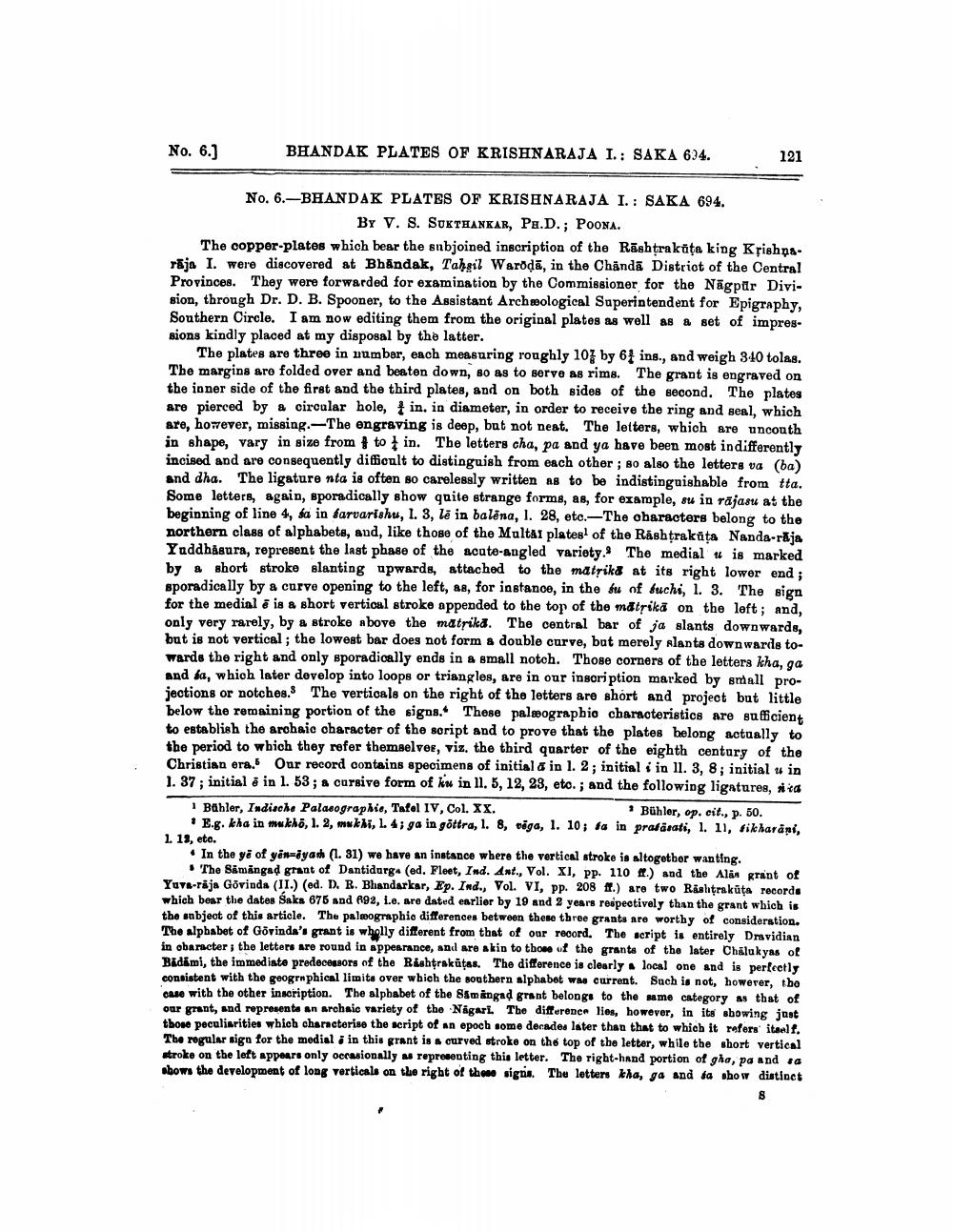________________
No. 6.]
BHANDAK PLATES OF KRISHNARAJA I.: SAKA 634.
121
No. 6.-BHANDAK PLATES OF KRISHNARAJA I.: SAKA 694. BY V. S. SUKTHANKAR, PH.D.; POONA.
The copper-plates which bear the subjoined inscription of the Rashtrakuta king Krishnaraja I. were discovered at Bhandak, Tahsil Waroda, in the Chanda District of the Central Provinces. They were forwarded for examination by the Commissioner for the Nagpur Division, through Dr. D. B. Spooner, to the Assistant Archeological Superintendent for Epigraphy, Southern Circle. I am now editing them from the original plates as well as a set of impressions kindly placed at my disposal by the latter.
The plates are three in number, each measuring roughly 103 by 6 ins., and weigh 340 tolas. The margins are folded over and beaten down, so as to serve as rims. The grant is engraved on the inner side of the first and the third plates, and on both sides of the second. The plates are pierced by a circular hole, in. in diameter, in order to receive the ring and seal, which are, however, missing. The engraving is deep, but not neat. The letters, which are uncouth in shape, vary in size from to in. The letters cha, pa and ya have been most indifferently incised and are consequently difficult to distinguish from each other; so also the letters va (ba) and dha. The ligature nta is often so carelessly written as to be indistinguishable from tta. Some letters, again, sporadically show quite strange forms, as, for example, su in rajasu at the beginning of line 4, sa in farvarishu, 1. 3, le in balena, 1. 28, etc.-The characters belong to the northern class of alphabets, and, like those of the Multar plates1 of the Rashtrakuta Nanda-raja Yuddhasura, represent the last phase of the acute-angled variety. The medial u is marked by a short stroke slanting upwards, attached to the matrika at its right lower end; sporadically by a curve opening to the left, as, for instance, in the fu of fuchi, 1. 3. The sign for the medial is a short vertical stroke appended to the top of the matrika on the left; and, only very rarely, by a stroke above the matrika. The central bar of ja slants downwards, but is not vertical; the lowest bar does not form a double curve, but merely slants downwards towards the right and only sporadically ends in a small notch. Those corners of the letters kha, ga and fa, which later develop into loops or triangles, are in our inscription marked by small projections or notches. The verticals on the right of the letters are short and project but little below the remaining portion of the signs. These paleographic characteristics are sufficient to establish the archaic character of the script and to prove that the plates belong actually to the period to which they refer themselves, viz. the third quarter of the eighth century of the Christian era. Our record contains specimens of initial & in l. 2; initial i in 11. 3, 8; initial u in 1. 37; initial è in 1. 53; a cursive form of ku in 11. 5, 12, 23, etc.; and the following ligatures, ta Bühler, op. cit., p. 50.
1 Bühler, Indische Palaeographie, Tafel IV, Col. XX.
E.g. kha in mukhō, 1. 2, mukhi, 1. 4; ga in gottra, 1. 8, vega, 1. 10; sa in prafäsati, 1. 11, sikharāni,
1. 13, etc.
In the ye of yên-ayam (1. 31) we have an instance where the vertical stroke is altogether wanting.
The Sämängad grant of Dantidurga (ed. Fleet, Ind. Ant., Vol. XI, pp. 110 f.) and the Alas grant of Yuva-raja Govinda (II.) (ed. D. R. Bhandarkar, Ep. Ind., Vol. VI, pp. 208 ff.) are two Rashtrakuta records which bear the dates Saka 675 and 692, i.e. are dated earlier by 19 and 2 years respectively than the grant which is the subject of this article. The paleographic differences between these three grants are worthy of consideration. The alphabet of Govinda's grant is wholly different from that of our record. The script is entirely Dravidian in obaracter; the letters are round in appearance, and are akin to those of the grants of the later Chalukyas of Badami, the immediate predecessors of the Rashtrakutas. The difference is clearly a local one and is perfectly consistent with the geographical limits over which the southern alphabet was current. Such is not, however, the case with the other inscription. The alphabet of the Samängad grant belongs to the same category as that of our grant, and represents an archaic variety of the Nagari. The difference lies, however, in its showing just those peculiarities which characterise the script of an epoch some decades later than that to which it refers itself. The regular sign for the medial in this grant is a curved stroke on the top of the letter, while the short vertical stroke on the left appears only occasionally as representing this letter. The right-hand portion of gha, pa and sa shows the development of long verticals on the right of these signs. The letters kha, ga and sa show distinct
8




